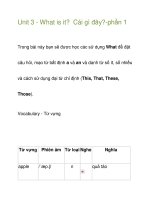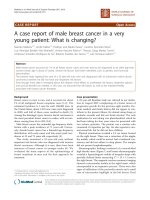Who mc topic 1 what is patient safety
Bạn đang xem bản rút gọn của tài liệu. Xem và tải ngay bản đầy đủ của tài liệu tại đây (69.98 KB, 14 trang )
Topic 1
What is patient safety?
Learning objective
Understand the discipline of patient safety and its
role in minimizing the incidence and impact of
adverse events, and maximizing recovery from
them
Knowledge requirements
harm caused by health-care errors and system
failures
lessons about error and system failure from other
industries
history of patient safety and the origins of the blame
culture
difference between system failures, violations and
errors
a model of patient safety
Performance requirements
apply patient safety thinking in all clinical activities
demonstrate ability to recognize the role of patient
safety in safe health-care delivery
Harm caused by health-care errors
and system failures
• extent of adverse events
• categories of adverse events
• economic costs
• human costs
Lessons about error and system failure from
other industries
• large-scale technological disasters
• what investigations showed
• what is a systems approach
Swiss cheese model
Why do interns make prescribing errors? A qualitative study MJA 2008; 188 (2): 89-94
Ian D Coombes, Danielle A Stowasser, Judith A Coombes and Charles Mitchell
Adapted from Reason’s model of accident causation
History of patient safety and origins
of the blame culture
• blame culture in health care
• Why do we blame?
• person approach
• systems approach
Difference between system
failures, violations and errors
• professional accountability
• violations
• types of violations
A model of patient safety
1. Those who work in health care.
2. Those who receive health care or have a stake in its
availability.
3. The infrastructure of systems for therapeutic interventions
(health-care delivery processes).
4. The methods for feedback and continuous improvement.
Recipients of care
Methods: CQI on
info, hardware,
plant, policy
Preparation on:
illness
understanding,
accessing care
systems,
advocacy
Systems for therapeutic
action designed to
preempt/rescue from failure
Workers: teams
trained to preempt /
rescue from /
manage failure
Methods: CQI
on: competence
communication,
teamwork
A patient safety model of health care Emmanuel et al 2008
Knowledge & Expertise
Patients
•
•
•
•
•
Clinicians
experience of illness •
social circumstances •
•
attitude to risk
•
values
•
preferences
diagnosis disease
etiology
prognosis
treatment options
outcome
probabilities
Coulter A Picker Institute 2001
Students should:
• understand the multiple factors involved in failures
• avoid blaming
• practise evidenced-based care
• maintain continuity of care for patients
• be aware of the importance of self-care
• act ethically everyday
Demonstrate ability to recognize
the role of patient safety in safe
health-care delivery
1. Ask questions about other parts of the health
system.
2. Ask for information about the hospital or clinic
processes that are in place to identify adverse
events.









